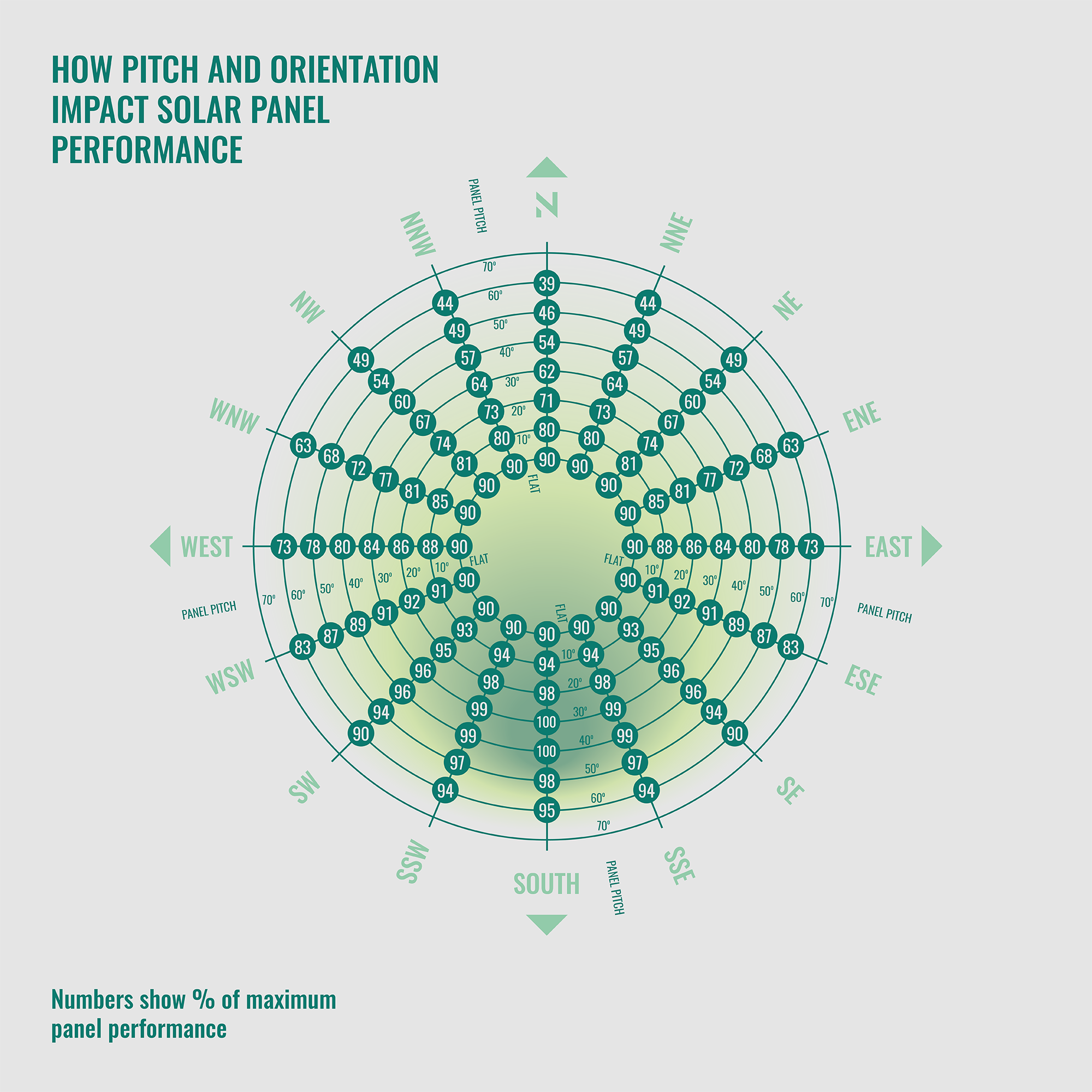8 Environmental Factors That Affect Solar Panel Performance
Choosing the right make and type of solar panel is only half the story. Even if you invest in top-of-the-range high efficiency solar panels, there are 8 main environmental variables that can dramatically affect the performance of your solar system and how suitable it is to the way you live.

The diagram above shows how to site a Solar PV array to maximise annual generation. However, maximum generation may not be right for your needs. As most arrays generate more energy in the summer than your property can use and don’t generate enough in the winter, having an array with a steeper pitch than normal, e.g. 60°, would increase your winter generation and reduce your summer generation. So even though the overall generation would be lower, you’d be able to reduce your bills more because you’d use up more of the energy you made. Equally, an East/West array may generate less over the year but if you’re using more electricity in mornings and evenings you may find that this orientation has a bigger impact on your bills, too.
The key thing to remember is that it’s always more economical to use your energy than export it back to the grid. With this in mind, pitch and orientation are the two biggest factors that affect solar panel performance, so we’ll start with them…
1. Solar Panel Orientation
The biggest factor affecting solar panel performance is orientation (ie the direction your roof is facing.) Panels on south-facing roofs generate more electricity because they catch the sun for longer and more directly than any other orientation. However, as noted already, maximum annual generation is not necessarily the best option for you – when you use your generated power (by day, and by season) are a huge factor. And, as can be seen from the diagram, all roof orientations, including north-facing can offer economical results if carefully installed at the right pitch…
2. Solar Panel Pitch
The ‘optimum’ pitch (ie the angle of the panels from horizontal) is about 30° in the UK. However, it’s generally accepted that 30° – 45° degrees is suitable for most roof- or ground-mounted systems. Again, depending on your own particular needs, it can make sense to reduce or increase from this recommendation in order to optimise your personal usage of energy generated.
3. Shading
Anything blocking direct or indirect sunlight from trees & hills to chimneys, flues and even overhead cables will have an impact and may make it worth considering which roofs you use or which way you face your panels on a ground mount.
4. The Albedo Effect
Albedo takes account of light reflection which is much more prevalent if you’re near the coast as a lot of light reflects off the surface of the water. Even several miles inland you can see a significant increase in generation so it may be worth considering orienting your array away from direct south to capture a bit more energy from reflected light.
5. Local Weather
Some areas are prone to fog in the morning or other meteorological phenomena that may impact generation at different times of day leading to a change in the choice of panel orientation.
6. Birds & Other Animals
On occasion, birds have been known to nest on or under solar PV panel installations. This can cause cable insulation damage and decrease panel ventilation while ‘bird strikes’ can cause extra shading on the panels. Sometimes animals have been known to chew on cables but they only do it once. While these issues are uncommon, if you have concerns you can have protection added to your array to prevent the intruders from settling.
7. Ammonia & Salt Mist
Ammonia is prevalent near to farm animals and salt mist occurs in coastal areas. Both can be corrosive solar panel frames. While it might not directly affect the performance it can reduce the life of your array. Many brands have certificates of their resistance to these two types of corrosion. Be aware that there are 6 levels of severity that solar panels are tested under IEC 61701 so if you live near the coast or farms ensure you’re choosing panels tested to ‘Maximum Severity’.
8. Should I Clean My Panels?
Solar panels will benefit from a clean, but not as much as many cleaning services claim. Naked Solar tested panels next to each other at a location within 1km of the sea on a 30° pitch roof.. Using 3 identical panels, we cleaned one every 6 months, one every 2 months and one we left dirty. The difference in performance between the highest and the lowest was just under 1%.
Why? Well in the UK we get enough liquid sunshine to keep the worst of the dirt off anyway.
If you’re in an area where there is a lot of dust, or high salt then you may want to clean them more often. Pitch again plays a part here. If your panels are set at a shallow angle, it may take more rain to shift the dirt. All that said, once a year is probably enough for the vast majority of installations to keep your system in top condition.
With so many variables, how can you work out what to do? Naked Solar use PV Sol software which takes into account shading, albedo, local weather and many more factors that impact the performance of a Solar PV system. Using PV Sol software gives Naked Solar customers a ‘try before you buy’ scenario, allowing you to test and compare different systems before investing in your new solar array. It’s crucial to our promise of always giving you an informed choice.